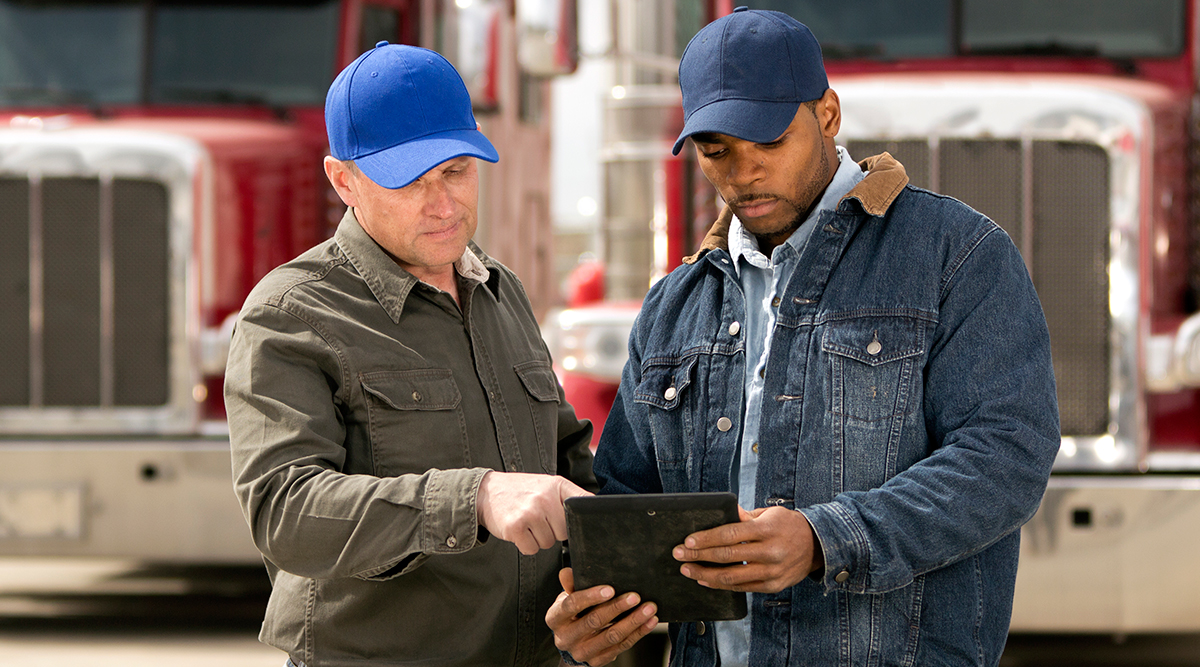
Two truck drivers having a meeting using a tablet computer. (Getty Images)
Throughout my logistics career, I have developed and implemented operational processes for building collaborative relationships with asset trucking companies, gathering data on their needs and developing freight matching technology to improve efficiency in the marketplace.
Even in today’s technology advanced environment, matching freight with capacity, particularly in the spot market, remains a labor-intensive process.
2018 TOP 100 PRIVATE CARRIERS: See the new rankings
LIVEONWEB: Watch “Orchestrating the Supply Chain”
Regardless of technology, the transportation industry is still built on relationships. The critical nature, value and pace of the service we provide requires trusted partnerships. Carriers, shippers and third-party logistics providers choose to work with, and ultimately will only share information with, companies they trust. Private load boards shared by email, through company websites or bid boards can connect partners directly, but their one-to-one nature limits their efficiency and usage by carriers. While public load boards have always provided excellent technology, their public nature limits participation.

Noam Frankel
“Uber for Freight” companies have marketed digital freight matching technology to their clients but offer it as a brokerage service, while the larger freight brokers and 3PLs are rolling out comparable technology with the experience, manpower and relationships to offer better execution. To a driver, is one company’s phone app really better than another’s when it only provides access to that one company’s freight?
So how can today’s tech trends such as visibility, connectivity and blockchain impact the current freight matching landscape?
We now have mobile devices inside trucks collecting a wide variety of data on drivers and equipment, with industry adoption accelerated by electronic logging device requirements.
The first stage has focused on freight tracking and visibility.
Now companies can begin applying that data to capacity utilization and freight matching.
And soon we will start utilizing historical data for predictive analytics and strategic sourcing.
The most advanced of these systems can incorporate weather, traffic, hours of service and engine diagnostics into estimating arrival times. They also know what restaurant a driver visits every Wednesday, and the traffic lanes that truck drives regularly.
Through integrations across the supply chain, that data can be communicated in real time directly to transportation, fleet and warehouse management systems, and software providers who offer added value such as matching freight with available capacity.
In this new digital age, when more proprietary data is getting collected but privacy concerns are coming to the forefront, how much more protective will carriers be about who has access to their data, and how much more selective will they be about who they choose to share it with?
The stage is now set for digital freight matching services to offer connectivity between shippers, carriers and logistics companies in a collaborative rather than competitive environment. I call these “collaborative capacity exchanges.”
But there are certain requirements for a true collaborative capacity exchange:
- It should be technology agnostic, able to connect transportation companies regardless of what platform they are on.
- It must integrate data coming from a wide variety of platforms and return results back to them.
- Providing participants control over who has access to their data is critical, because true collaboration requires trust and choice on who you want to play with.
- To drive efficiency and usage, it needs to be a centralized solution, allowing shippers and carriers to connect with all of their partners from one place, and identifying matches from aggregated data.
- And finally, a true collaborative capacity exchange should sell technology services to freight companies rather than trying to steal their customers and drivers.
Noam Frankel is founder and CEO of FreightFriend. He was a co-founder and COO of American Backhaulers and ran the operations for the first 10 years and built its initial technology. He also served as vice president of truckload sales and operations at Echo Global Logistics and founded Optimal Freight, which was acquired by TFI subsidiary Transport America.
Original Source: https://www.ttnews.com/articles/building-case-true-collaboration
